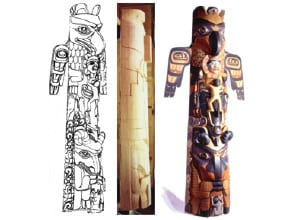
 |
“Seeking the Light” Thunderbird and the Sun Carved by 10’ 6” |
The Crandall Family Totem Pole
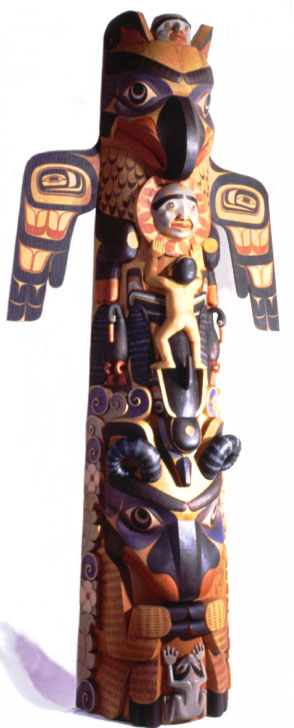 |
The Crandall totem pole is a “house post” carved in the Northwest-Coast Indian style. The authentic use of a house post was to be a main supporting member of a central beam in a home. Its carvings are the family crests and legends of the household owners. The physical position of this pole is usually directly under a main beam. “Totem pole” is the name originally given by Europeans to the carved wooden pillars made by the Indian peoples of the American Northwest Coast. The concept of “totem” is most often used to refer to the symbolic relationship existing between natural phenomena (usually animals) and human groups. This does not mean that the human group had the literal characteristics of their totem. Rather it means that they belong to a kinship group which has alegendary relationship with the totem. When a totem pole was to be carved, the artist was given freedom as to how he chose to portray the figures. Often he included mischievous objects of his own invention. The Crandall totem pole is 10.5 feet high, 28” diameter at the base, weighs 250 lbs. and is carved from a 500-year old Red Cedar tree. It was carved in January – April, 1998 after extensive discussions about family and life background during a visit with the artist, Duane Pasco (see End Notes). |
THE DOLPHIN
There is no main figure on a pole. Every figure has meaning. On this pole, the Dolphin is one of the Crandall family crests. Its choice celebrates the close encounter between human and animal that so typically became the source of adoption of a specific animal for a family crest among the Northwest-Coast Indians. In the Crandall family the closest wild animal encounters have been with dolphins. One of these encounters was potentially threatening but turned out to be a “connection” instead. The dolphin is also perhaps the most endearing animal in the sea – a habitat that plays a strong part in Crandall life.
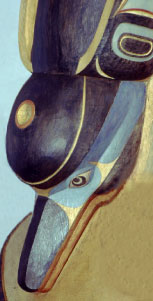
Brett, as an eight-year-old boy, encountered a dolphin while snorkeling in Hawaii. The large dolphin approached and Brett extended a foot to touch him. The dolphin engulfed the foot in his mouth, closing his huge, blunt teeth on the leg (playfully, Brett asserted afterwards, and indeed the dolphin seemed perfectly mindful of his delicate playmate). Seconds later, the leg came out unharmed. It was an unforgettable scene.
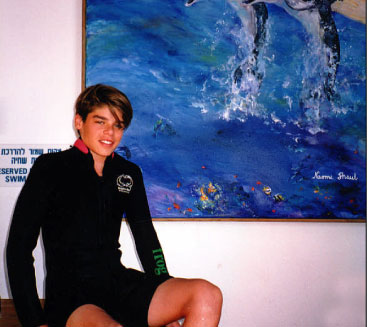
Other encounters with Dolphins include a sequence captured on videotape in the Red Sea in Israel, where a dolphin became attracted to Rick and Wayne and engaged in play that seemed almost human. Yet another contact occurred after a dive trip by Rick and Brett in Isla des los Roques, Venezuela. Just minutes after the last dive of a week of diving, with uncanny timing, a group of Dolphins showed up, jumping and frolicking as though to say “goodbye until next time.”
THE THUNDERBIRD
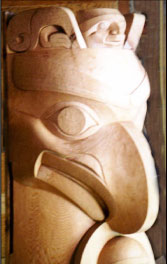
The Thunderbird, a mythical type of eagle, appears on the top of the pole. It is distinguished from the normal eagle totem by its supernatural horns, its large curved, humped beak, and its accentuated talons and legs in comparison with other bird forms. Lightning and thunder are the signs of his flight. His wings are usually shown out-thrust, a dramatic statement of his flying abilities.
The Thunderbird is another family crest, due to its special connection with father Nat. Dad fought in World War II in the historic 45th Infantry Division, whose fabled march made history from its brutal initial beach landing at Anzio, then following immediately behind General Patton across Europe and ending with its participation in the liberation of Dachau. There were many dangerous maneuvers, and among them Dad led his troops through mine fields and enemy fire encounters that won him two bronze star medals. The insignia for the 45th is the Thunderbird – selected for its origin as an American Indian symbol signifying “sacred bearer of happiness unlimited.” The arm patch for the Thunderbird Division is a yellow bird on a red background.
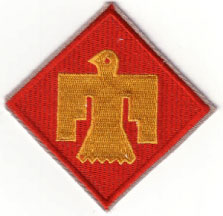
Original Thunderbird Division arm patch
The human face between the horns of the Thunderbird was a mischievous addition by the artist. The human figure shares body parts (his arms and hands double as the Thunderbird’s horns) in the traditional Indian style of portraying transformation between animal and human.

Story of the Thunderbird: In the Beginning …
The Sun, the Raven and the Thunderbird play a prominent part in myths about the origin of the world. As the legend goes, in the early times there was no light and the world was in darkness. There was no firm boundary between man and animal, and each took the form of the other readily. The Sun existed but had been stored by an old man in a box within a box within a box, etc. The old man had a daughter he loved dearly, but he didn’t want to take the chance of releasing the Sun for fear of seeing that his daughter might be ugly.
Meanwhile, the Raven got bored of bumping around the world in the dark and in typical fashion, snuck into the old man’s home transformed as a boy posing as a son. The man was delighted to have a second child.
The Raven-child began working his child-like persuasive ways on the old man, finally getting consent to open the outer-most box. After more pestering, the old man let the boy open the second box. This went on until so many boxes had been opened that a glow appeared from the remaining few boxes, hinting at the Sunwithin. Finally the boy opened the last box, transformed back into a full Raven, took the Sun in his beak, and flew out the window.
Instantly the world came partially aglow from the Sun being partially hidden in the Raven’s beak. The Raven had no good intention, as he wanted to keep the Sun for himself. However, the Thunderbird caught sight of the Raven and intercepted him in mid-air. He jostled the Sun loose from the Raven, grabbed it in his beak and thrust it up high where it would shine for the entire world. The old man, in the new light of the Sun, saw that his daughter was indeed beautiful, and so he no longer was angry at the loss of the Sun.
It is said that since the world has been lit by the Sun, the boundary between animals and man became more distinct. However, each man has a special relationship with an animal that persists, and transformations are still said to be possible.
BIG-HORN SHEEP
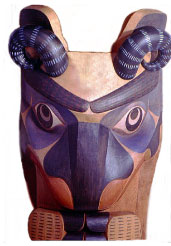
At the base of the pole is the Big-horn Mountain Sheep which is native to the Colorado mountains. This magnificent animal is present on the pole extending a permanent welcome to our mountain home for friends and family. The Rocky Mountain Big Horn Sheep are tenacious mountain hikers which has become one of Rick’s passions in Colorado.
THE OYSTER-CATCHER
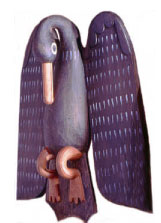
The two Oyster-catcher birds increase the power of anything they are associated with. The Oyster-catcher is the most-often used animal appearing on the shaman’s rattle, a device that was used in official ceremonies by a tribe’s shaman (a counsel, oracle, and medicine man) to heighten the effectiveness of the ceremony. The appearance of the Oyster-catchers makes the other totems on the pole especially effective in their roles.
BOY ON A DOLPHIN: REACHING FOR THE SUN

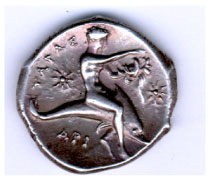
The most prominent “action sequence” on the pole is the boy-on-a-dolphin reaching to touch the sun. The scene signifies the strong inter-relationship between man and nature. The boy is assisted by the dolphin in reaching skywards towards new heights, as if stretching to do the impossible – to touch the sun itself. The sun is also a metaphor for knowledge, and the scene signifies that the quest for knowledge creates a life-giving and life-extending pursuit.
The boy-on-a-dolphin motif also appears in the story of Taras, the son of Poseidon, the God of the Sea in ancient Greek mythology (circa 700 BC). According to legend, Taras was the son of Poseidon by a nymph. When Taras’ ship was sunk in a storm off the coast of southern Italy, a friendly dolphin carried him to shore on his back, thus saving his life. Believing his rescue to be a sign of providence, Taras founded the city of Tarantum (Taras) on the spot where he had so miraculously been brought to land. Tarantum became the most important Greek city in southern Italy during the 5th and 4th centuries BC.
The ancient Greek silver coin (left) commemorated the story. The coin is a 2 drachma piece that served as the main currency in Taras for nearly 300 years. It was worth approximately 2 days’ wages.
The story typifies the many real accounts of heroic assistance given to man by the dolphin in sea-disaster stories throughout the ages.
THE FROG
The Frog figures prominently in Northwest-Coast Indian mythology. He is involved in several stories as a carrier of wealth and knowledge. It is good to have the frog around as a symbol of good fortune.
This frog story is from the legend of Dzelarhons, a native woman who chose isolation in the mountains to escape being abused as a wife among strange tribes:
Alone in the forest, Dzelarhons listened to the frogs and learned to mimic their sounds and songs. She lived on the side of the mountain that seethed with fire and molten rock. One day she noticed balls of fire spewing forth from the center and she began running down the mountain, croaking like a frog. The frogs in the forest heard and understood, and soon all the frogs began running down the mountain. The scene of Dzelarhons and all the frogs rushing down panicked the people in the villages. At first they caught the frogs and threw them into their fires, but instead of dying the frogs transformed into supernatural beings, and the only thing left of their physical beings were their copper ornaments, melted down. This strange outcome further panicked the people and they all fled to the sea, which saved their lives from the Volcano.
A huge fireball shot down and destroyed the village, leaving only the melted remains of the copper. The people learned that the copper could be pounded into implements and plates and figured prominently in restoring village life. Copper is associated with wealth that had been brought by the frogs.
END NOTES
- Color Palette – Authentic colors were limited to what could be made by the native artists with natural and local materials. These were mixed with salmon eggs to provide a more permanent oil base.

Black was made from grinding mud and charcoal with a mortar
Blue/green was made from copper oxide or sulfide (blue clays)
Red was made from earth ochre
White was made from crushed, burnt clamshell
2. Floral Carvings – The floral carvings on the lower sides of the pole
signify the wildflowers found in profusion in the mountains. Photographing wildflowers has long been one of Rick’s joys. Towards the middle of the pole the flowers transform into waves lapping at the Oyster Catchers and Dolphin.

DUANE PASCO
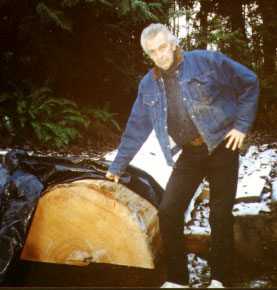
Since 1966, Duane Pasco has become one of the most influential artists working in the genre of Northwest Coast art. Born in Seattle in 1932, he grew up on Cook Inlet in Alaska among the Eskimos and Athabascan Indians. He creates his art in a studio styled after a traditional Northwest Coast native longhouse on five forested acres on Bainbridge Island near Seattle.
Pasco’s resume is 23 pages long. Recently he made the marionettes used by the Carter family to portray Makah tales. Before that he was chosen by Disney to carve two huge 53’ poles for a hotel project in Florida.
He always speaks modestly and with few, but direct words. “The art form has only been revived in the past 35 years, and the sculptors have not yet had enough time to become masters,” said Pasco in a newspaper interview. The facts are that he has played a major role in revitalizing many of the art forms native to Northwest-Coast people.
As far back as 1969 he was selected to teach at the ‘Ksan Project, a government-funded facility called the Gitenmaax School of Northwest Coast Indian Art, to return the skill of native art to the Gitksan people. More recently, Pasco spent time teaching Klallam carvers how to construct canoes in the style traditional to their tribe.
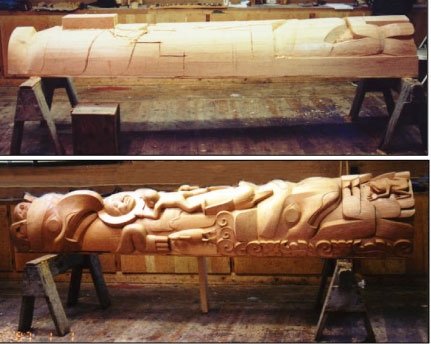
“Seeking the Light”
Excerpted from Duane Pasco Studios web site: http://www.duanepasco.com/wp/totems/
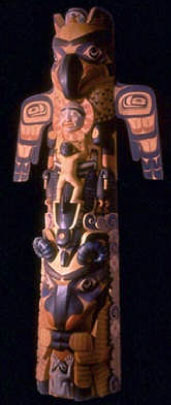
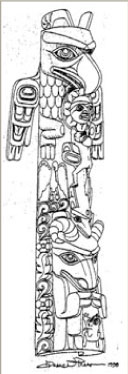
“Seeking the Light” conceptual sketch
10’h x 3’w. Rick Crandall collection.
Carved from western red cedar with acrylic paint. I was touched by an account the client related to me regarding his son at the age of eight years.
The boy was snorkeling in Hawaii when a dolphin swam up to him and gently took hold of his foot. Pulling his foot loose, he swam around and grasped the tail of the porpoise who made no effort to flee. Instead the two continued swimming, alternating their roles for a time. This experience had a lasting effect on him.
Apparently the boy is very intelligent with a curious nature, never tiring of learning. The sun on this pole represents light and is a metaphor for knowledge, which the boy seeks. Other representations on this pole are a thunderbird, two oystercatchers, mountain sheep, frog, waves, and anonymous floral details, all of which have special significance for the client.
Seeking Knowledge
Rick Crandall
knowl-edge (nol’ij) n.
- acquaintance with facts, truths, or principles;
- familiarity or conversance
- awareness
- the sum of what is known
Life begins with learning, develops with learning and continues to be worth living as long as knowledge is sought. When learning ceases, the end of life is not far away.
Knowing facts and methods and the nature of living things is the path to wealth; knowledge is more valuable than things: with knowledge you can create things, but with things you cannot create knowledge.
Knowing another person is the way to being a true friend, and is the greatest gift
for it makes him immortal through your remembrance.
Knowledge comes partly from being a student and partly from being a teacher
Knowledge comes from seeing the world from many perspectives:
- From a high vantage where the whole can be seen, where the future can be glimpsed and where perspective can be gained;
- From an immersion in the detail, the minutiae, where the richness of life can be encountered first hand
Knowledge comes from nature:
- From the heavens where the eagle soars;
- From the land, where man reigns
- From the seas where the dolphin roams
When man is in the air, he is a guest of the eagle,
When he is under the water, he is a guest of the dolphin,
When he is on land, he is a guest of other men,
In any situation, you must never forget to know what the eagle knows –
Look at the big picture;
And you must never forget to know what the dolphin knows –
Immerse into to the depths of things;
When among men, be aware –
There is always someone who knows more than you know.


